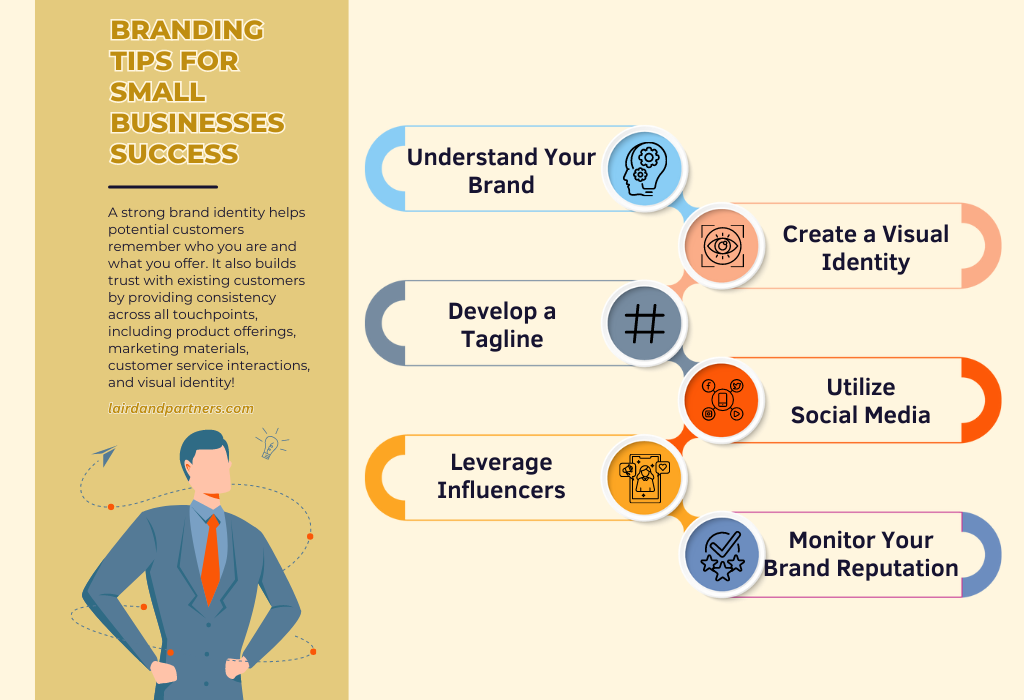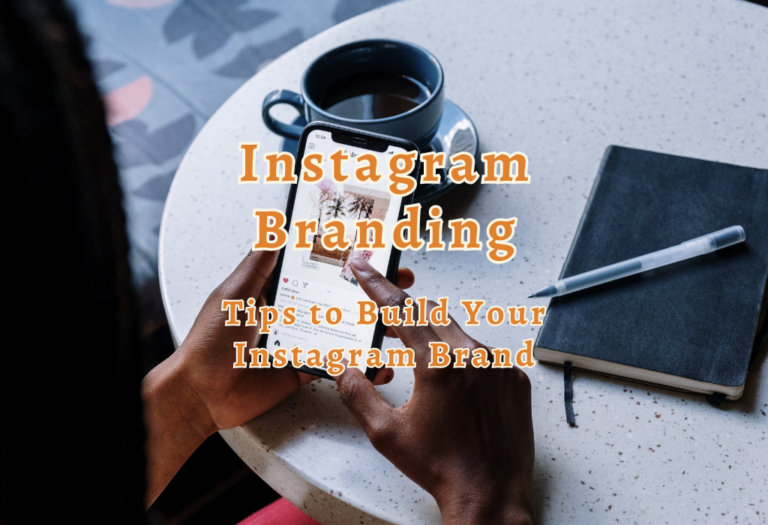6 Essential Branding Tips for Small Businesses Success
In today’s world, where thousands of businesses compete for attention, it can be challenging to stand out from the crowd. That’s where branding comes in.
In simple terms, branding is the process of creating a unique name and image for your business that sets you apart from competitors!

More Resources :
The Importance of Branding
A strong brand identity helps potential customers remember who you are and what you offer. It also builds trust with existing customers by providing consistency across all touchpoints, including product offerings, marketing materials, customer service interactions, and visual identity!
Branding Creates Recognition
A well-defined brand personality helps consumers recognize your company easily among other brands in the market.
Branding Establishes Trust
Consistency in messaging and visuals creates an impression on people that they can rely on a particular brand, which leads to building trust over time.
Branding Generates New Revenue Streams
Strong branding attracts new clients/customers through word-of-mouth referrals or influencer marketing, which ultimately drives more sales resulting in revenue growth over time.
As a small business owner, you might think that branding is reserved only for big brands like Coca-Cola or Apple. However, even the smallest businesses can benefit from implementing effective branding strategies.
In this article, we will discuss seven key steps to help you build a powerful brand for your small business. From understanding your brand’s core values and creating a visual identity, to leveraging influencers and monitoring your reputation – these actionable insights will set you on the path towards successful brand building.
Branding Tips for Small Businesses Success

1. Understand Your Brand
By examining the competition and analyzing customer demands, small businesses can create a distinctive brand identity that stands out from their peers.
A. Research Competitors
To build an effective brand strategy, it’s essential to analyze what successful competitors are doing right and identify areas where you can differentiate yourself. Look at their marketing materials, product offerings, and online presence to gain insights into their branding strategies.
B. Identify Customer Needs
Your brand should address the needs of potential customers by offering solutions to their problems or fulfilling their desires. Conduct market research through surveys or interviews to understand what they expect from companies like yours – this will help inform your messaging and overall marketing plan.
2. Create a Visual Identity
To ensure recognition and memorability, it’s important to craft a unified aesthetic that communicates your brand’s personality and core values.
Designing a Logo
As your logo is the first thing customers see when engaging with your brand, it should be unique and memorable to effectively communicate what your company stands for. Therefore, it should be distinct, easily recognizable and encapsulate the values of your organization. You can either create your own logo or enlist the help of a professional designer to ensure it is unique, memorable and accurately reflects your company’s values.
Selecting Colors and Fonts
The colors you choose will play an important role in conveying emotions associated with your brand. For example, blue represents trustworthiness while red signifies passion or energy. Consider researching color psychology before settling on specific shades that best represent your business’ core values.
In addition to colors, selecting appropriate fonts also contributes significantly towards building a strong visual identity. Choose fonts that are easy-to-read yet distinctive enough from others in the market space; this way existing customers will easily identify them as part of your branding guidelines.
Tips:
Designing Marketing Materials
Beyond logos and color schemes, it’s essential to create visually appealing marketing materials such as business cards, flyers, brochures or even visual content for social media platforms. Ensure these materials follow your branding guidelines while effectively communicating your brand message to potential customers.
3. Develop a Tagline
A tagline is an important part of any brand’s identity, as it helps to create a memorable impression in the minds of potential customers. It should be short, catchy, and accurately reflect your company’s mission or values. To create an effective tagline that can contribute to building a strong brand identity, it is important to consider some tips.
Keep It Short and Simple
Keep it brief and memorable. Aim for no more than five words – this will make it easier for people to recall when they think about your brand. Consider some famous examples like Nike’s “Just Do It” or McDonald’s “I’m Lovin’ It.” Both are simple yet impactful statements that resonate with their target audience.
Incorporate Keywords
If possible, include relevant keywords in your tagline to improve search engine visibility and reinforce what makes you unique among other small businesses within the same industry sector. However, don’t force them into the text at the expense of readability or meaning.
Create Emotional Appeal
Test Your Tagline
Before finalizing your tagline, it’s important to gather feedback from others – this can include friends, family members, colleagues, or even existing customers. Ask them for their honest opinions and consider making adjustments based on their input.
4. Utilize Social Media
With the increasing number of people using social media platforms, it has become an essential tool for small businesses to build their brand identity and connect with potential customers. By creating accounts on relevant platforms, you can engage your target audience through regular content posting and interactions.
A. Choose the Right Platforms
To make the most out of social media branding, identify which platforms are popular among your target audience. For instance, if you’re targeting a younger demographic, consider focusing on Instagram or TikTok; whereas LinkedIn might be more suitable for B2B marketing.
B. Develop a Consistent Brand Voice
Your brand voice should reflect your company’s personality and values across all marketing channels, including social media posts. This helps create a cohesive image that resonates with your ideal customer while reinforcing brand recognition.
C. Share Engaging Content
D. Interact With Your Followers
By engaging with your followers through comments, questions, and content sharing/liking, you can cultivate a strong bond between them and your brand – enhancing customer loyalty and boosting word-of-mouth referrals. This fosters customer loyalty and increases the likelihood of word-of-mouth referrals.
E. Monitor Analytics
Regularly reviewing social media analytics allows you to track engagement rates, audience demographics, and other important metrics that inform future marketing strategies. Use tools like Google Analytics, Facebook Insights, or platform-specific dashboards to measure the effectiveness of your campaigns.
F. Utilize Paid Advertising Options
If budget permits, consider investing in paid advertising options such as Facebook Ads or Instagram Sponsored Posts to reach a wider audience and boost revenue growth through targeted promotions.
5. Leverage Influencers

Influencer marketing involves partnering with individuals who have a strong online presence and influence over your target audience, allowing you to tap into their network of followers.
A. Identify the Right Influencers
The first step in leveraging influencers is identifying those who align with your brand values and appeal to your ideal customer base. Look for individuals who are active on social media platforms relevant to your industry and have an engaged following that matches your target demographic. Tools like BuzzSumo or Klear can help streamline this process by providing insights into influencer profiles based on keywords or topics related to your business.
B. Establish Genuine Relationships
Rather than simply paying influencers for sponsored posts, focus on building genuine relationships with them by engaging in authentic conversations about shared interests or values related to your product offering. This approach will not only create more meaningful partnerships but also foster trust between the influencer and their audience when they promote your brand.
C. Collaborate on Content Creation
Involving influencers in content creation allows you both to benefit from each other’s expertise while showcasing unique perspectives that resonate with different segments of the market – ultimately leading towards stronger brand recognition among potential customers. Some examples of collaborative content include:
6. Monitor Your Brand Reputation
Monitoring your brand reputation is crucial for small businesses to maintain a strong brand identity and ensure customer satisfaction. By tracking what is being said about your brand online, you can quickly address any issues that could be impacting the public’s opinion of your business and work to improve it. Here are some key steps to effectively monitor and manage your brand reputation:
A. Track Reviews on Social Media Platforms
Social media platforms such as Yelp, Google My Business, and Facebook offer customers an opportunity to share their experiences with a particular business, both positive and negative. Regularly keeping an eye on these customer feedbacks can offer valuable insight into how customers view your offerings, thus allowing you to make the necessary changes.
B. Respond to Customer Inquiries Timely
Maintaining open communication channels with potential customers helps build trust in your brand while also providing valuable information about their needs and preferences. Ensure that all questions and requests sent through social media, email, or other marketing avenues are answered quickly.
C. Utilize Online Reputation Management Tools
There are various tools available that can help streamline the process of monitoring mentions of your company across different websites and social networks like Mention or Hootsuite. These tools allow you to keep tabs on conversations involving your business so that you can respond accordingly when needed.
D. Engage in Influencer Marketing Strategically
E. Encourage Customer Reviews
Positive reviews from satisfied customers can significantly boost your business’s reputation. Encourage existing customers to leave reviews on relevant platforms, either through incentives like discounts or simply by asking them directly after they’ve had a positive experience with your product or service.
Start Building Your Brand Now!
At Laird and Partners, we specialize in helping small businesses build successful brands through our expertise in branding strategies and marketing plans. Contact us now to discover how our proficiency in branding approaches and advertising plans can help your small business flourish!






